Exploring Organizational Culture and Patient Safety in Healthcare
VerifiedAdded on 2023/06/04
|9
|1709
|446
Essay
AI Summary
This essay explores the critical relationship between organizational culture and patient safety within healthcare organizations. It highlights how elements such as leadership, teamwork, and communication significantly influence patient safety outcomes. The essay discusses the importance of effective leadership in communicating vision, motivating employees, and fostering a culture of continuous improvement. It emphasizes the need for a 'just culture' where employees feel safe to voice concerns and report errors without fear of retribution, promoting learning and preventing future incidents. Through reflections on clinical placements, the essay illustrates how breakdowns in communication, lack of support, and inadequate resources can compromise patient safety, underscoring the necessity for healthcare organizations to cultivate supportive and communicative environments to ensure optimal patient care and minimize preventable errors. The essay concludes with a questionnaire designed to assess the key elements of organizational culture related to patient safety.

Running head: PATIENT SAFETY
PATIENT SAFETY
Name of the student:
Name of the university:
Author note:
PATIENT SAFETY
Name of the student:
Name of the university:
Author note:
Paraphrase This Document
Need a fresh take? Get an instant paraphrase of this document with our AI Paraphraser

1
PATIENT SAFETY
Introduction:
The topic of patient safety mainly revolves around the ways by which the hospitals and
other healthcare organizations protect their patients from errors, accidents, injuries and even
infections. This is an important aspect as every year about 440,000 people are seen to die from
preventable errors in the hospitals (Weller et al., 2014). Studies have suggested that
organizational culture in the healthcare industries play an important role in ensuring the patient
safety in the healthcare units. It mainly refers to the wide range of the social phenomena that
includes organization’s customary dress, behavior, languages, behaviors, beliefs, values,
authority, myths, symbols of status, ceremonies and rituals and even modes of deference and
subversion. In simple words, it mainly explains the set of guiding beliefs, understanding as well
as the ways of thinking which the members of the organizations share to meet their goals and
objectives. This assignment will show the various ways by which the elements of organizational
culture influence patient safety in healthcare organizations.
Leadership, teamwork and communication:
Organizational cultures, which influence effective leaderships, can contribute to the
culture of patient safety. Studies that healthcare professionals who are leaders in the organization
have the capabilities of communicating vision to the employees and motivating them in ways by
which the latter can work beyond their goals to achieve the vision (Guldenmund et al., 20170.
Leaders who explain the importance of patient safety to the subordinates, helping them with
strategies by which they can develop skills and knowledge of patient safety and can solve all
their concerns of achieving patient safety can ensure the best outcome (Reis et al., 2018).
Development of the team morale, continuous boosting of the team members to strive for patient
PATIENT SAFETY
Introduction:
The topic of patient safety mainly revolves around the ways by which the hospitals and
other healthcare organizations protect their patients from errors, accidents, injuries and even
infections. This is an important aspect as every year about 440,000 people are seen to die from
preventable errors in the hospitals (Weller et al., 2014). Studies have suggested that
organizational culture in the healthcare industries play an important role in ensuring the patient
safety in the healthcare units. It mainly refers to the wide range of the social phenomena that
includes organization’s customary dress, behavior, languages, behaviors, beliefs, values,
authority, myths, symbols of status, ceremonies and rituals and even modes of deference and
subversion. In simple words, it mainly explains the set of guiding beliefs, understanding as well
as the ways of thinking which the members of the organizations share to meet their goals and
objectives. This assignment will show the various ways by which the elements of organizational
culture influence patient safety in healthcare organizations.
Leadership, teamwork and communication:
Organizational cultures, which influence effective leaderships, can contribute to the
culture of patient safety. Studies that healthcare professionals who are leaders in the organization
have the capabilities of communicating vision to the employees and motivating them in ways by
which the latter can work beyond their goals to achieve the vision (Guldenmund et al., 20170.
Leaders who explain the importance of patient safety to the subordinates, helping them with
strategies by which they can develop skills and knowledge of patient safety and can solve all
their concerns of achieving patient safety can ensure the best outcome (Reis et al., 2018).
Development of the team morale, continuous boosting of the team members to strive for patient
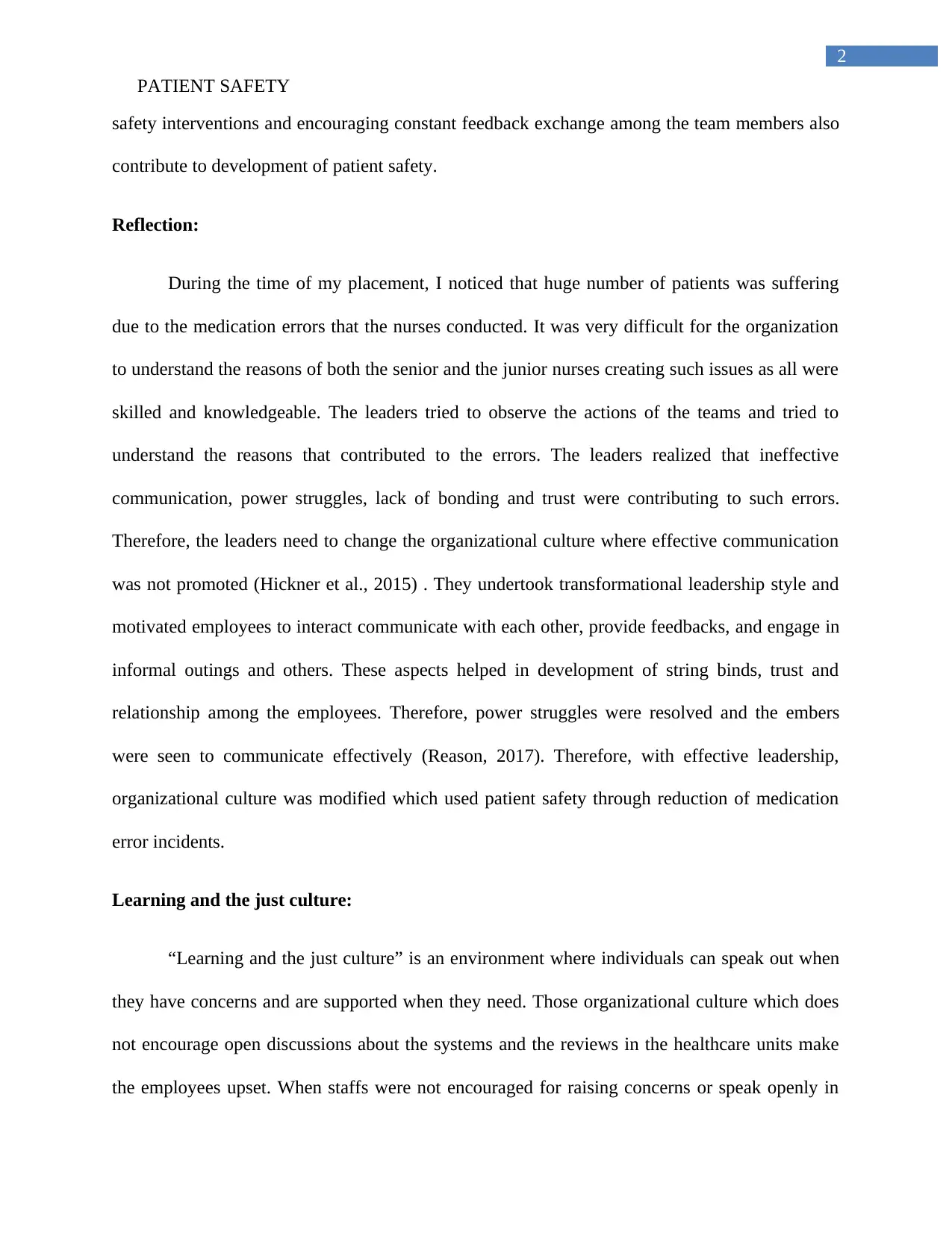
2
PATIENT SAFETY
safety interventions and encouraging constant feedback exchange among the team members also
contribute to development of patient safety.
Reflection:
During the time of my placement, I noticed that huge number of patients was suffering
due to the medication errors that the nurses conducted. It was very difficult for the organization
to understand the reasons of both the senior and the junior nurses creating such issues as all were
skilled and knowledgeable. The leaders tried to observe the actions of the teams and tried to
understand the reasons that contributed to the errors. The leaders realized that ineffective
communication, power struggles, lack of bonding and trust were contributing to such errors.
Therefore, the leaders need to change the organizational culture where effective communication
was not promoted (Hickner et al., 2015) . They undertook transformational leadership style and
motivated employees to interact communicate with each other, provide feedbacks, and engage in
informal outings and others. These aspects helped in development of string binds, trust and
relationship among the employees. Therefore, power struggles were resolved and the embers
were seen to communicate effectively (Reason, 2017). Therefore, with effective leadership,
organizational culture was modified which used patient safety through reduction of medication
error incidents.
Learning and the just culture:
“Learning and the just culture” is an environment where individuals can speak out when
they have concerns and are supported when they need. Those organizational culture which does
not encourage open discussions about the systems and the reviews in the healthcare units make
the employees upset. When staffs were not encouraged for raising concerns or speak openly in
PATIENT SAFETY
safety interventions and encouraging constant feedback exchange among the team members also
contribute to development of patient safety.
Reflection:
During the time of my placement, I noticed that huge number of patients was suffering
due to the medication errors that the nurses conducted. It was very difficult for the organization
to understand the reasons of both the senior and the junior nurses creating such issues as all were
skilled and knowledgeable. The leaders tried to observe the actions of the teams and tried to
understand the reasons that contributed to the errors. The leaders realized that ineffective
communication, power struggles, lack of bonding and trust were contributing to such errors.
Therefore, the leaders need to change the organizational culture where effective communication
was not promoted (Hickner et al., 2015) . They undertook transformational leadership style and
motivated employees to interact communicate with each other, provide feedbacks, and engage in
informal outings and others. These aspects helped in development of string binds, trust and
relationship among the employees. Therefore, power struggles were resolved and the embers
were seen to communicate effectively (Reason, 2017). Therefore, with effective leadership,
organizational culture was modified which used patient safety through reduction of medication
error incidents.
Learning and the just culture:
“Learning and the just culture” is an environment where individuals can speak out when
they have concerns and are supported when they need. Those organizational culture which does
not encourage open discussions about the systems and the reviews in the healthcare units make
the employees upset. When staffs were not encouraged for raising concerns or speak openly in
⊘ This is a preview!⊘
Do you want full access?
Subscribe today to unlock all pages.

Trusted by 1+ million students worldwide
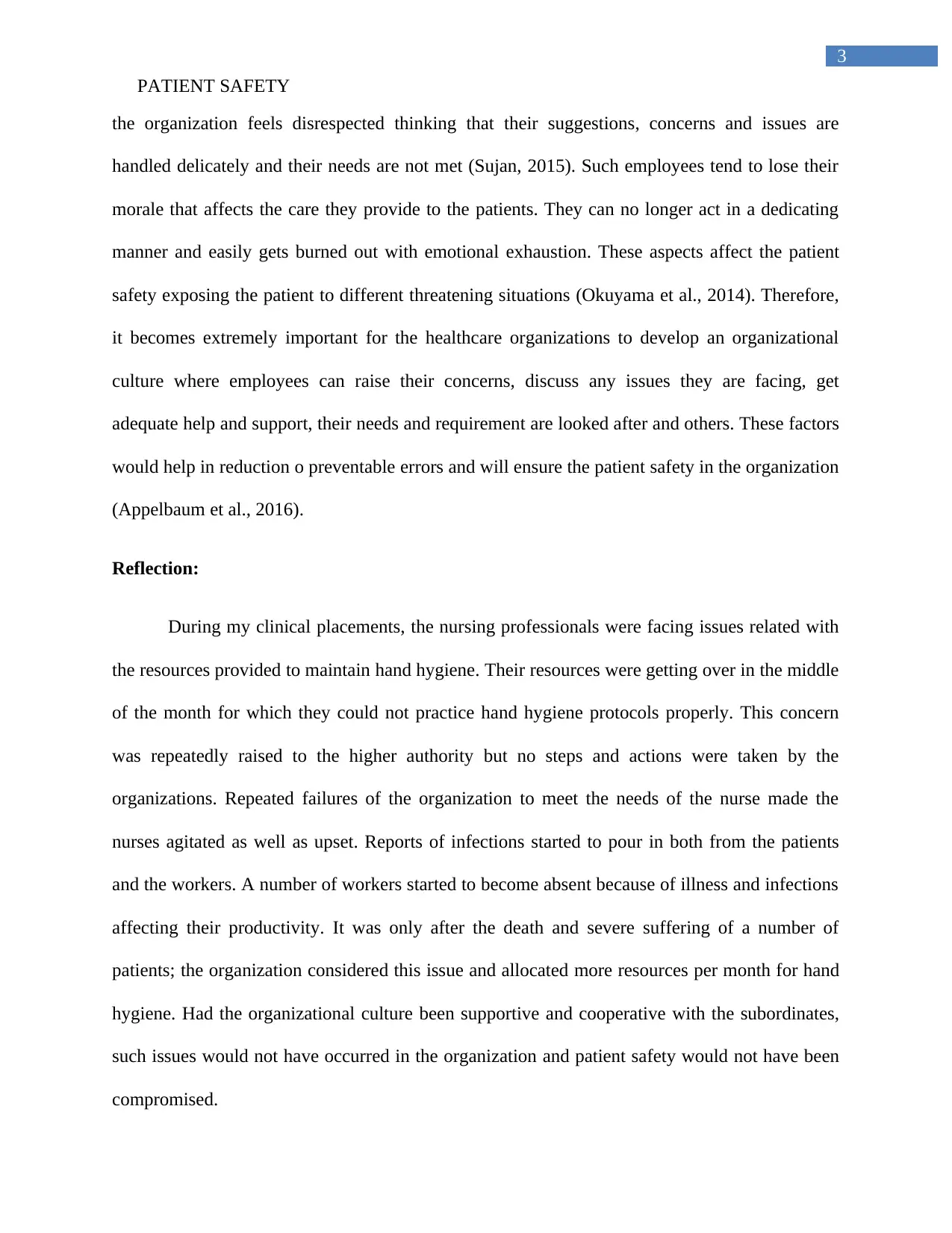
3
PATIENT SAFETY
the organization feels disrespected thinking that their suggestions, concerns and issues are
handled delicately and their needs are not met (Sujan, 2015). Such employees tend to lose their
morale that affects the care they provide to the patients. They can no longer act in a dedicating
manner and easily gets burned out with emotional exhaustion. These aspects affect the patient
safety exposing the patient to different threatening situations (Okuyama et al., 2014). Therefore,
it becomes extremely important for the healthcare organizations to develop an organizational
culture where employees can raise their concerns, discuss any issues they are facing, get
adequate help and support, their needs and requirement are looked after and others. These factors
would help in reduction o preventable errors and will ensure the patient safety in the organization
(Appelbaum et al., 2016).
Reflection:
During my clinical placements, the nursing professionals were facing issues related with
the resources provided to maintain hand hygiene. Their resources were getting over in the middle
of the month for which they could not practice hand hygiene protocols properly. This concern
was repeatedly raised to the higher authority but no steps and actions were taken by the
organizations. Repeated failures of the organization to meet the needs of the nurse made the
nurses agitated as well as upset. Reports of infections started to pour in both from the patients
and the workers. A number of workers started to become absent because of illness and infections
affecting their productivity. It was only after the death and severe suffering of a number of
patients; the organization considered this issue and allocated more resources per month for hand
hygiene. Had the organizational culture been supportive and cooperative with the subordinates,
such issues would not have occurred in the organization and patient safety would not have been
compromised.
PATIENT SAFETY
the organization feels disrespected thinking that their suggestions, concerns and issues are
handled delicately and their needs are not met (Sujan, 2015). Such employees tend to lose their
morale that affects the care they provide to the patients. They can no longer act in a dedicating
manner and easily gets burned out with emotional exhaustion. These aspects affect the patient
safety exposing the patient to different threatening situations (Okuyama et al., 2014). Therefore,
it becomes extremely important for the healthcare organizations to develop an organizational
culture where employees can raise their concerns, discuss any issues they are facing, get
adequate help and support, their needs and requirement are looked after and others. These factors
would help in reduction o preventable errors and will ensure the patient safety in the organization
(Appelbaum et al., 2016).
Reflection:
During my clinical placements, the nursing professionals were facing issues related with
the resources provided to maintain hand hygiene. Their resources were getting over in the middle
of the month for which they could not practice hand hygiene protocols properly. This concern
was repeatedly raised to the higher authority but no steps and actions were taken by the
organizations. Repeated failures of the organization to meet the needs of the nurse made the
nurses agitated as well as upset. Reports of infections started to pour in both from the patients
and the workers. A number of workers started to become absent because of illness and infections
affecting their productivity. It was only after the death and severe suffering of a number of
patients; the organization considered this issue and allocated more resources per month for hand
hygiene. Had the organizational culture been supportive and cooperative with the subordinates,
such issues would not have occurred in the organization and patient safety would not have been
compromised.
Paraphrase This Document
Need a fresh take? Get an instant paraphrase of this document with our AI Paraphraser
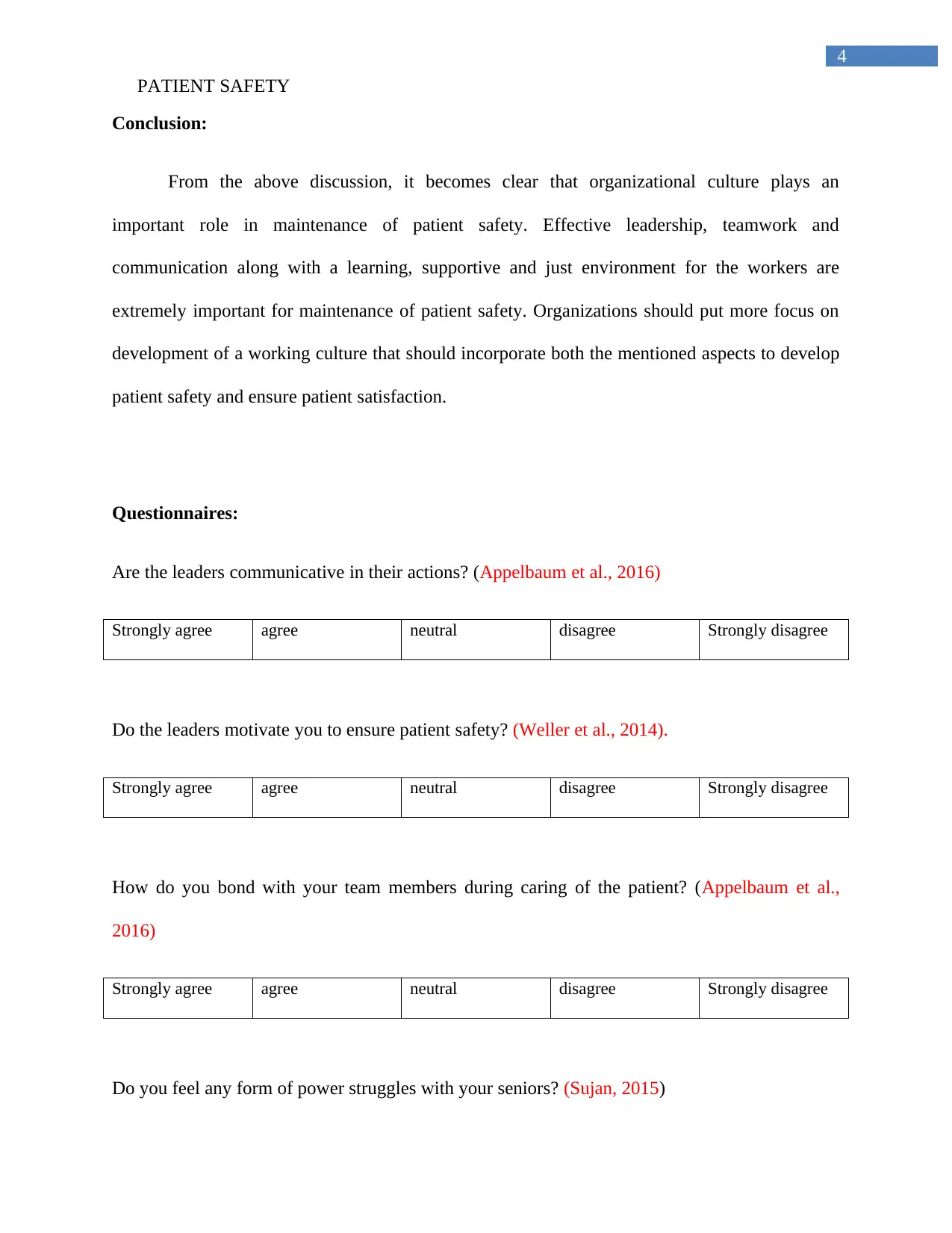
4
PATIENT SAFETY
Conclusion:
From the above discussion, it becomes clear that organizational culture plays an
important role in maintenance of patient safety. Effective leadership, teamwork and
communication along with a learning, supportive and just environment for the workers are
extremely important for maintenance of patient safety. Organizations should put more focus on
development of a working culture that should incorporate both the mentioned aspects to develop
patient safety and ensure patient satisfaction.
Questionnaires:
Are the leaders communicative in their actions? (Appelbaum et al., 2016)
Strongly agree agree neutral disagree Strongly disagree
Do the leaders motivate you to ensure patient safety? (Weller et al., 2014).
Strongly agree agree neutral disagree Strongly disagree
How do you bond with your team members during caring of the patient? (Appelbaum et al.,
2016)
Strongly agree agree neutral disagree Strongly disagree
Do you feel any form of power struggles with your seniors? (Sujan, 2015)
PATIENT SAFETY
Conclusion:
From the above discussion, it becomes clear that organizational culture plays an
important role in maintenance of patient safety. Effective leadership, teamwork and
communication along with a learning, supportive and just environment for the workers are
extremely important for maintenance of patient safety. Organizations should put more focus on
development of a working culture that should incorporate both the mentioned aspects to develop
patient safety and ensure patient satisfaction.
Questionnaires:
Are the leaders communicative in their actions? (Appelbaum et al., 2016)
Strongly agree agree neutral disagree Strongly disagree
Do the leaders motivate you to ensure patient safety? (Weller et al., 2014).
Strongly agree agree neutral disagree Strongly disagree
How do you bond with your team members during caring of the patient? (Appelbaum et al.,
2016)
Strongly agree agree neutral disagree Strongly disagree
Do you feel any form of power struggles with your seniors? (Sujan, 2015)
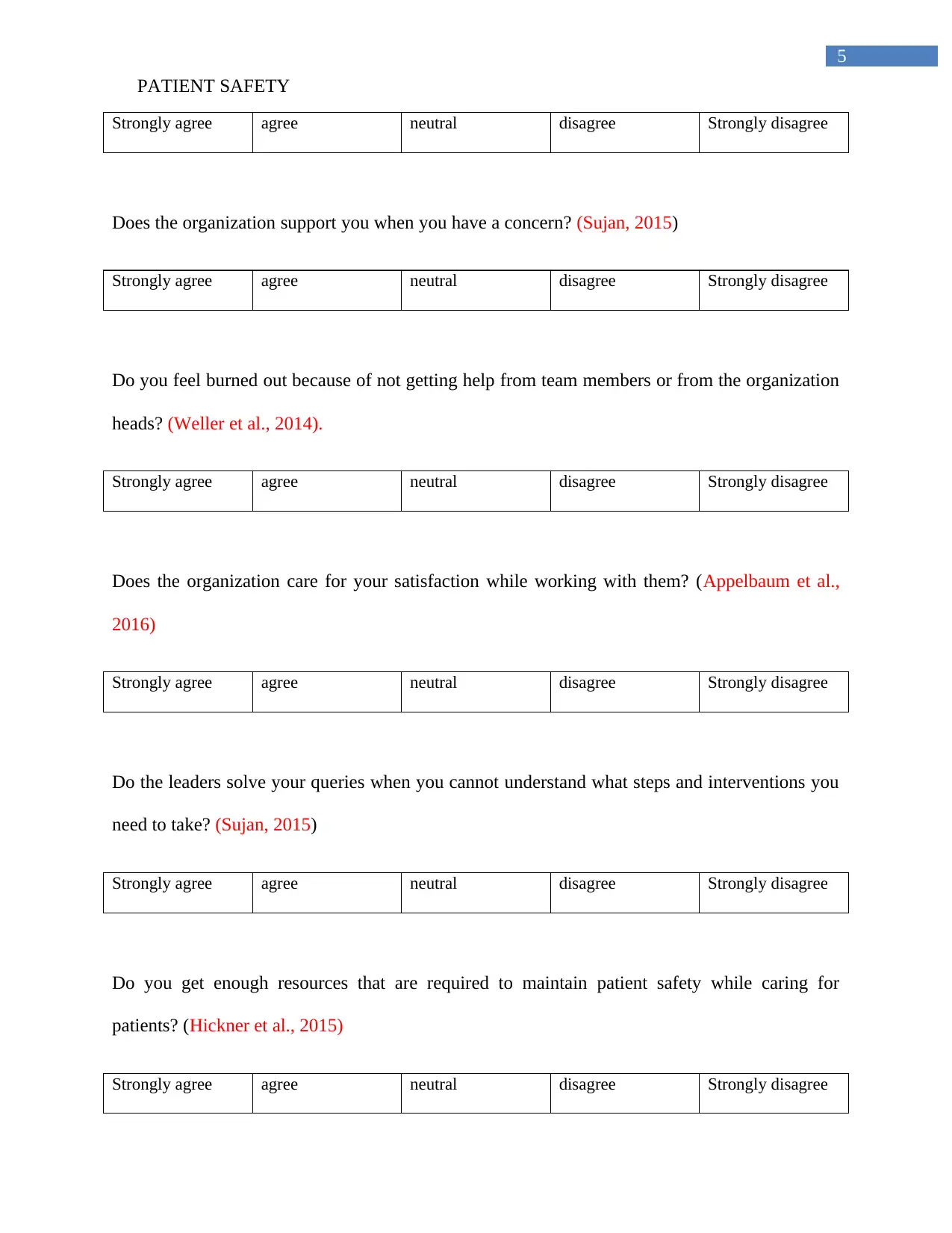
5
PATIENT SAFETY
Strongly agree agree neutral disagree Strongly disagree
Does the organization support you when you have a concern? (Sujan, 2015)
Strongly agree agree neutral disagree Strongly disagree
Do you feel burned out because of not getting help from team members or from the organization
heads? (Weller et al., 2014).
Strongly agree agree neutral disagree Strongly disagree
Does the organization care for your satisfaction while working with them? (Appelbaum et al.,
2016)
Strongly agree agree neutral disagree Strongly disagree
Do the leaders solve your queries when you cannot understand what steps and interventions you
need to take? (Sujan, 2015)
Strongly agree agree neutral disagree Strongly disagree
Do you get enough resources that are required to maintain patient safety while caring for
patients? (Hickner et al., 2015)
Strongly agree agree neutral disagree Strongly disagree
PATIENT SAFETY
Strongly agree agree neutral disagree Strongly disagree
Does the organization support you when you have a concern? (Sujan, 2015)
Strongly agree agree neutral disagree Strongly disagree
Do you feel burned out because of not getting help from team members or from the organization
heads? (Weller et al., 2014).
Strongly agree agree neutral disagree Strongly disagree
Does the organization care for your satisfaction while working with them? (Appelbaum et al.,
2016)
Strongly agree agree neutral disagree Strongly disagree
Do the leaders solve your queries when you cannot understand what steps and interventions you
need to take? (Sujan, 2015)
Strongly agree agree neutral disagree Strongly disagree
Do you get enough resources that are required to maintain patient safety while caring for
patients? (Hickner et al., 2015)
Strongly agree agree neutral disagree Strongly disagree
⊘ This is a preview!⊘
Do you want full access?
Subscribe today to unlock all pages.

Trusted by 1+ million students worldwide
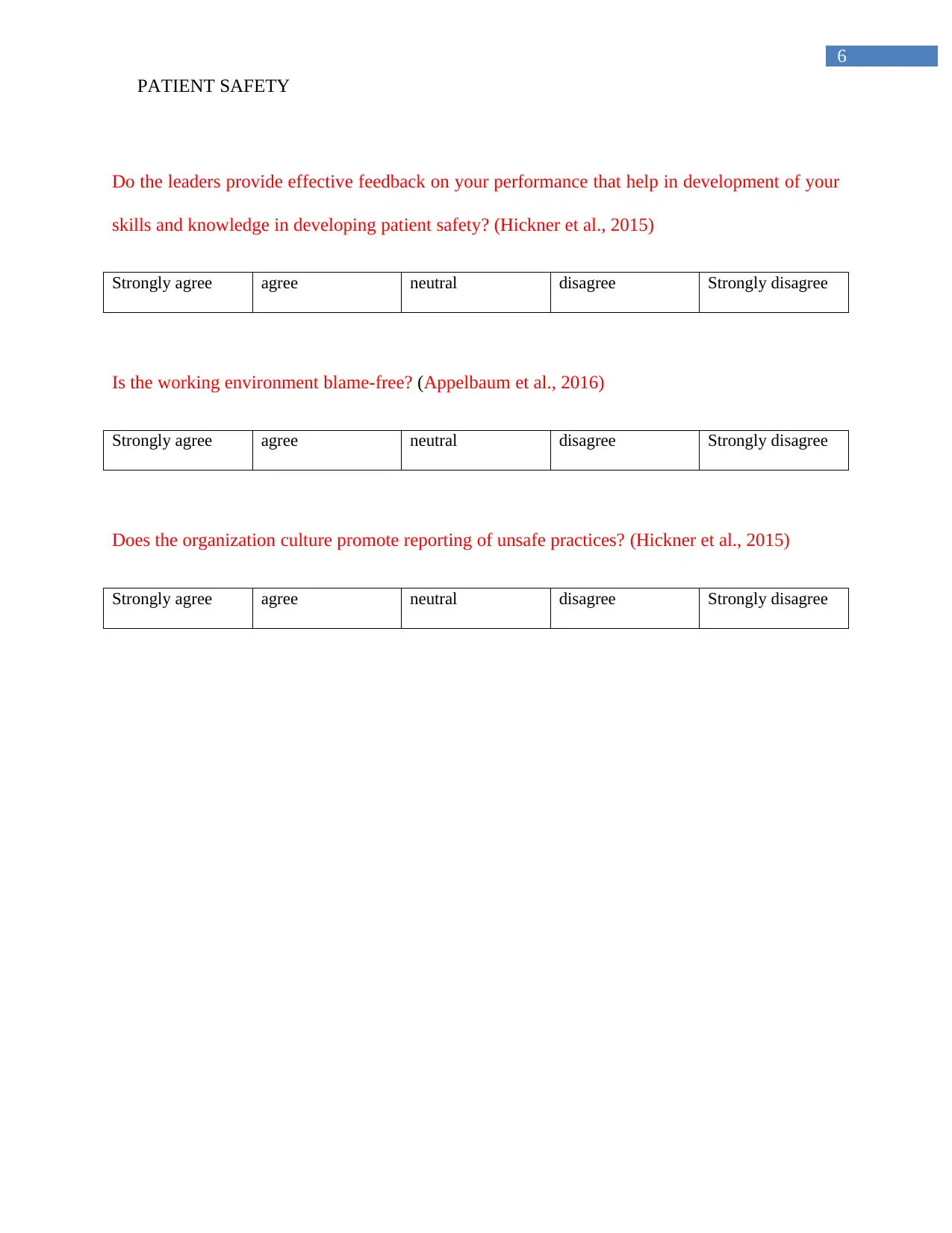
6
PATIENT SAFETY
Do the leaders provide effective feedback on your performance that help in development of your
skills and knowledge in developing patient safety? (Hickner et al., 2015)
Strongly agree agree neutral disagree Strongly disagree
Is the working environment blame-free? (Appelbaum et al., 2016)
Strongly agree agree neutral disagree Strongly disagree
Does the organization culture promote reporting of unsafe practices? (Hickner et al., 2015)
Strongly agree agree neutral disagree Strongly disagree
PATIENT SAFETY
Do the leaders provide effective feedback on your performance that help in development of your
skills and knowledge in developing patient safety? (Hickner et al., 2015)
Strongly agree agree neutral disagree Strongly disagree
Is the working environment blame-free? (Appelbaum et al., 2016)
Strongly agree agree neutral disagree Strongly disagree
Does the organization culture promote reporting of unsafe practices? (Hickner et al., 2015)
Strongly agree agree neutral disagree Strongly disagree
Paraphrase This Document
Need a fresh take? Get an instant paraphrase of this document with our AI Paraphraser

7
PATIENT SAFETY
References:
Appelbaum, N. P., Dow, A., Mazmanian, P. E., Jundt, D. K., & Appelbaum, E. N. (2016). The
effects of power, leadership and psychological safety on resident event
reporting. Medical education, 50(3), 343-350.
Guldenmund, F. (2017). Organisational safety culture principles. In Patient Safety Culture (pp.
43-69). CRC Press.
Hickner, J., Smith, S. A., Yount, N., & Sorra, J. (2015). Differing perceptions of safety culture
across job roles in the ambulatory setting: analysis of the AHRQ Medical Office Survey
on Patient Safety Culture. BMJ Qual Saf, bmjqs-2014.
Okuyama, A., Wagner, C., & Bijnen, B. (2014). Speaking up for patient safety by hospital-based
health care professionals: a literature review. BMC health services research, 14(1), 61.
Reason, J. (2017). The human contribution: unsafe acts, accidents and heroic recoveries. CRC
Press.
Reis, C. T., Paiva, S. G., & Sousa, P. (2018). The patient safety culture. International Journal
For Quality In Health Care.
Sujan, M. (2015). An organisation without a memory: a qualitative study of hospital staff
perceptions on reporting and organisational learning for patient safety. Reliability
engineering & system safety, 144, 45-52.
PATIENT SAFETY
References:
Appelbaum, N. P., Dow, A., Mazmanian, P. E., Jundt, D. K., & Appelbaum, E. N. (2016). The
effects of power, leadership and psychological safety on resident event
reporting. Medical education, 50(3), 343-350.
Guldenmund, F. (2017). Organisational safety culture principles. In Patient Safety Culture (pp.
43-69). CRC Press.
Hickner, J., Smith, S. A., Yount, N., & Sorra, J. (2015). Differing perceptions of safety culture
across job roles in the ambulatory setting: analysis of the AHRQ Medical Office Survey
on Patient Safety Culture. BMJ Qual Saf, bmjqs-2014.
Okuyama, A., Wagner, C., & Bijnen, B. (2014). Speaking up for patient safety by hospital-based
health care professionals: a literature review. BMC health services research, 14(1), 61.
Reason, J. (2017). The human contribution: unsafe acts, accidents and heroic recoveries. CRC
Press.
Reis, C. T., Paiva, S. G., & Sousa, P. (2018). The patient safety culture. International Journal
For Quality In Health Care.
Sujan, M. (2015). An organisation without a memory: a qualitative study of hospital staff
perceptions on reporting and organisational learning for patient safety. Reliability
engineering & system safety, 144, 45-52.
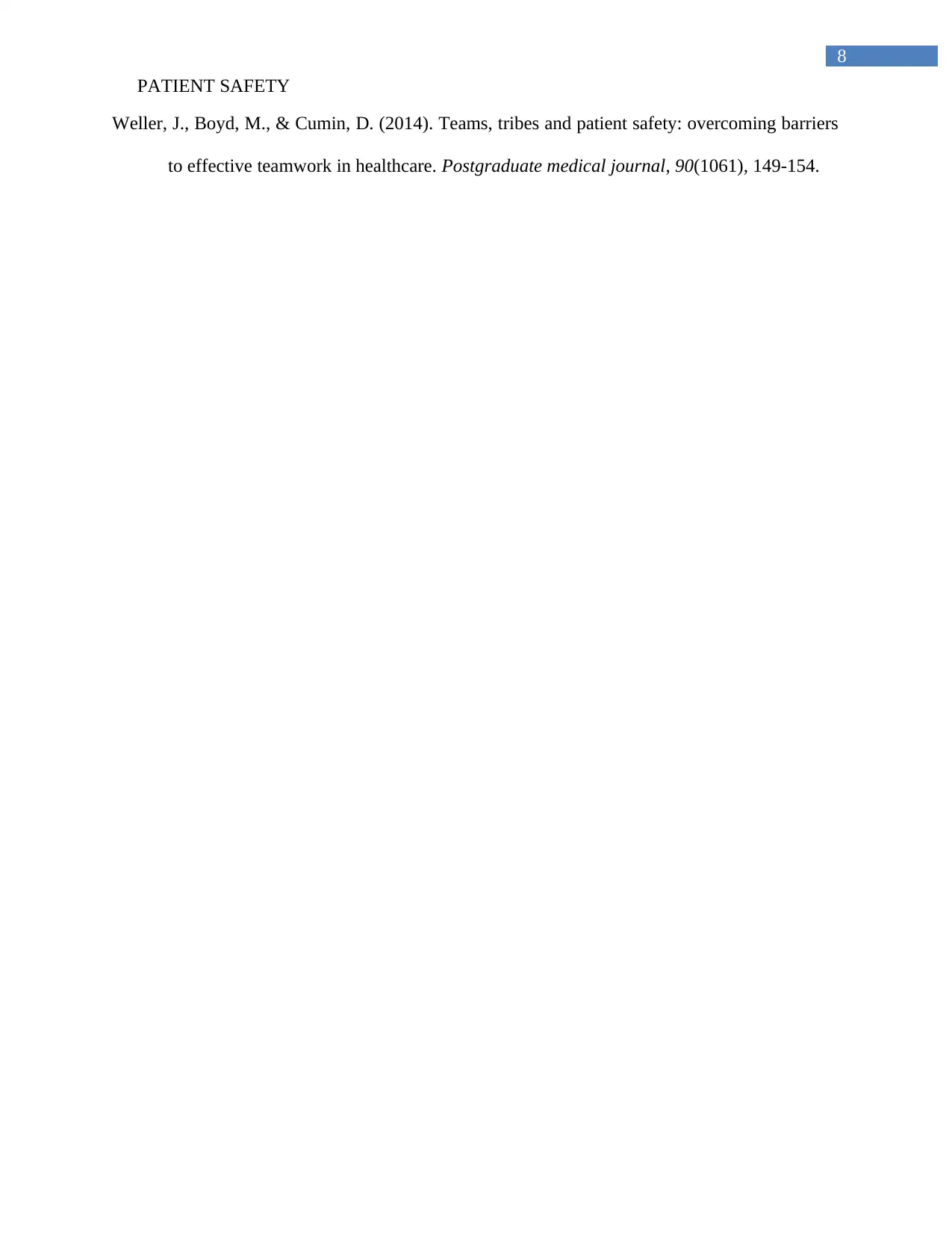
8
PATIENT SAFETY
Weller, J., Boyd, M., & Cumin, D. (2014). Teams, tribes and patient safety: overcoming barriers
to effective teamwork in healthcare. Postgraduate medical journal, 90(1061), 149-154.
PATIENT SAFETY
Weller, J., Boyd, M., & Cumin, D. (2014). Teams, tribes and patient safety: overcoming barriers
to effective teamwork in healthcare. Postgraduate medical journal, 90(1061), 149-154.
⊘ This is a preview!⊘
Do you want full access?
Subscribe today to unlock all pages.

Trusted by 1+ million students worldwide
1 out of 9
Related Documents
Your All-in-One AI-Powered Toolkit for Academic Success.
+13062052269
info@desklib.com
Available 24*7 on WhatsApp / Email
![[object Object]](/_next/static/media/star-bottom.7253800d.svg)
Unlock your academic potential
Copyright © 2020–2026 A2Z Services. All Rights Reserved. Developed and managed by ZUCOL.





